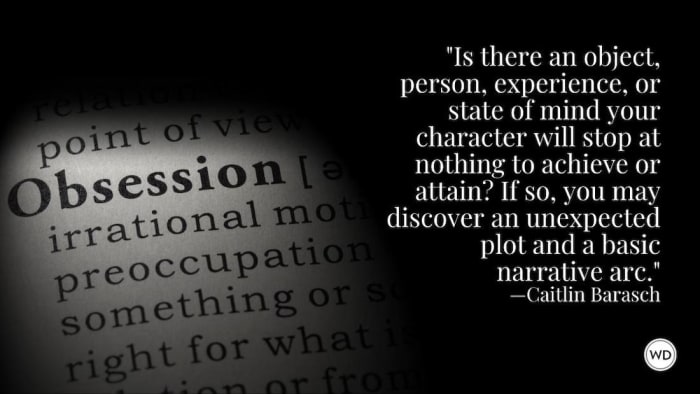How To Write a Character Driven by an Obsession
When setting out to write a piece of fiction, it’s likely you’ve been told to give your protagonist a singular desire. While this is good advice, I would urge you to take it a step further—what happens when your protagonist’s perhaps modest desire becomes an all-consuming obsession?
(Caitlin Barasch: On Curating Our Own Personal Stories)
My debut novel, aptly titled A Novel Obsession, is about an aspiring novelist named Naomi who becomes obsessed with her boyfriend’s ex, Rosemary. The more Naomi learns about Rosemary, the more her curiosity consumes her, and before she knows it, her obsessive internet stalking morphs into a friendship under false pretenses—and becomes the subject of her nascent novel.
Now, ask yourself: Is there an object, person, experience, or state of mind your character will stop at nothing to achieve or attain? If so, you may discover an unexpected plot and a basic narrative arc. Here are a few tips for propulsive storytelling involving obsession:
Make Sure Your Protagonist Takes Action
The obsession at the heart of my novel begins entirely as a figment of Naomi’s inner life, but as obsessive thoughts consume her, she’s eventually compelled to act upon them. And thus, what began as a thought experiment soon edges into the real world.
My advice, then, is to always make your obsessive protagonist active, not passive. Get out of their head and launch them into society: How does their behavior become altered by obsession? While of course human beings often have thriving inner lives that don’t always manifest as external actions, fiction is (blessedly) different from real life, and characters who make decisions, who act, are usually the most exciting to read about.
Allow your characters to flout social norms and even engage in some risky behavior, if the story calls for it.
IndieBound | Bookshop | Amazon
[WD uses affiliate links.]
Give Your Protagonist More Than One Obsession
Naomi’s obsession with Rosemary drives the action in my novel, but as the narrative unfolds, I aimed to slowly reveal what Naomi actually obsesses about when forced to look inward: Her unstable sense of self-worth, her desire to be desired, and her writing ambitions. Obsessions are often inevitable, mysterious, messy; when we dig a little deeper, and try to understand the source of our fixations, we might discover what revelations lie just beneath the surface.
Of course, if a novel features an unreliable narrator, they often withhold these truths from the reader as well as from themselves, and therein exists what I believe is a delicious narrative tension. What obsessions would your protagonist choose to confess to, and what obsession would they resolve to keep secret at all costs?
In a Sarah Lawrence course description on the thematic role of obsession, Emma Cline wrote: “I’m interested in how [obsessions] function as a portrait of their narrators—maps of their psychological topography.” She goes on to suggest obsession is a useful entry point into a story, which I strongly agree with—for writers and readers alike!—because it prompts the million-dollar-question we all begin asking at a very young age and never cease to: Why?
Not only does this question compel a reader to keep turning pages, but it also guides a writer toward unexpected discoveries. On behalf of your characters, make sure to keep asking why as well as how.
What Consequences Does Your Character Face?
Obsessions can be destructive—intense, all-consuming, sometimes misguided. So it seems inevitable that an obsession might wreak havoc as a result.
A character might be single-minded enough to neglect everything and everyone else in their life, or they might become compelled to do something unforgivable in service of their obsession. This is a sneaky way of saying books of all genres need high stakes: What does this character stand to lose?
This particular reckoning can easily serve as your novel’s climax—and since you’ve already asked yourself why and how, it’s finally time to ask: What happens in the aftermath?




